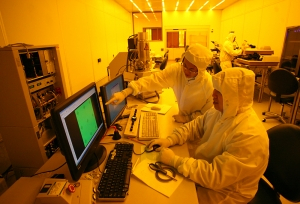Nanotechnology researchers at the University of Houston will soon be able to work faster than ever thanks to a grant from the National Science Foundation (NSF).
The $568,000 award will be used to purchase a nanolithography imprint system, which can cut the time it takes to create certain nanoparticles and features (which are measured in billionths of a meter) from hours – and even weeks – to mere minutes. The grant covers roughly 70 percent of the system’s purchase price, with the university covering the balance.
“This gives us the last piece we were missing,” said Dmitri Litvinov, professor of electrical and computer engineering with the UH Cullen College of Engineering and director of UH’s Nanofabrication Facility, where the system will be housed.
Since opening in 2011, the Nanofabrication Facility has been available to researchers across the university, no matter their department or college. The facility also welcomes businesses and researchers from outside UH, allowing the area’s entire nanotechnology community to come under one roof to share ideas and expertise.
One challenge faced by researchers at the Nanofabrication Facility – and on practically every nanotechnology-based project – is how time consuming this work can be. Electron-beam lithography, in which a focused beam of electrons is shot at a surface, is one of the most common methods for creating particles and features on the nanoscale. This technique creates these features one by one. At that rate, building a disk drive with one terabit of memory would require weeks of 24-7 operation, Litvinov said. Even simpler, smaller patterns can take several hours.
In nanolithography imprinting, though, researchers create a pattern on a surface with e-beam lithography and then use that pattern as a stamp. The stamp can then be pressed into surface after surface, allowing researchers to quickly create multiple samples. “It can be as simple as stamp and clamp,” said Litvinov.
This will be a boon to researchers conducting complex investigations, he added. “Some experiments require many samples at a very small scale. It can take a lot of repetition to optimize conditions like surface temperature and chemistry…With this, we can produce the stamp once and use it to make samples very quickly,” said Litvinov.
Not only will this device speed up nanotech research at UH, it will also allow for more flexibility in the patterns and particles researchers work with. Some nanotech companies do sell stamps, but their offerings are limited. With an in-house full suite of nanolithography tools for nanoimprint stamp fabrication, including commercial grade e-beam lithography and several reactive ion etchers, researchers at the Nanofabrication Facility will be able to customize their stamps to meet their exact needs.
In the Cullen College alone, there are multiple investigators poised to benefit from this new piece of equipment. Their efforts include:
• The development of nanopantography, a technique for mass-producing nanotechnology-based devices on a commercially viable scale. (Vincent Donnelly, professor of chemical and biomolecular engineering, and Demetre Economou, Hugh Roy and Lillie Cranz Cullen Distinguished University Chair of chemical and biomolecular engineering);
• Research into the optical and electrical properties of graphene, a one-atom-thick material that could be used in electronics devices to produce dramatic increases in computing power. (Jiming Bao, assistant professor of electrical and computer engineering; Wei-Chuan Shih, assistant professor of electrical and computer engineering; and James Tour, Rice University chemistry department);
• The fabrication of microscale retroreflectors, which reflect light directly back to its source. When coated with specific proteins, they can bond with disease biomarkers and be used to diagnose illnesses. (Paul Ruchhoeft, associate professor of electrical and computer engineering; Richard Willson, professor of chemical and biomolecular engineering; and Kirill Larin, associate professor of biomedical engineering).
Several other projects led by researchers from across UH will benefit from this new tool as well, including investigations into solar power, data storage and nanoparticle drug delivery. In combination with the Nanofabrication Facility’s in-house expertise, this system further establishes the facility as the premier center for nanotechnology research in the Houston area, Litvinov said. “We have an outstanding support staff in the Nanofabrication Facility. Now we have the full toolset to make stamps ourselves…This fills an important niche for the facility.”
